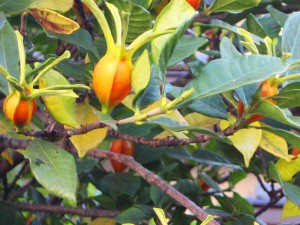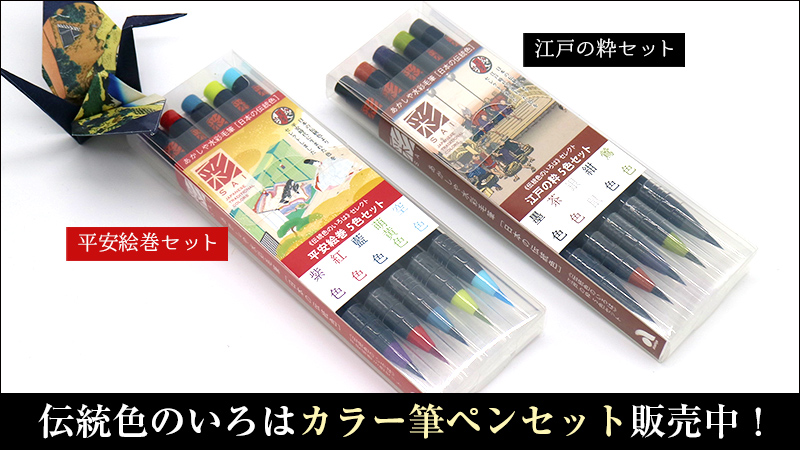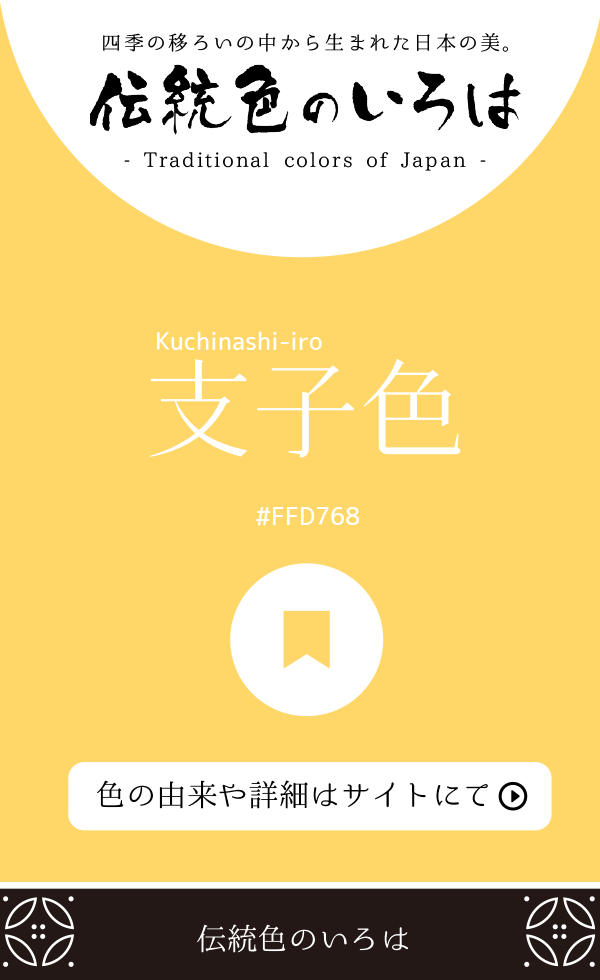| 色の名前Japan Color Name | 支子色(くちなしいろ) |
|---|---|
| ローマ字Romanized | Kuchinashi-iro |
| RGB | R:253 G:216 B:118 |
| CMYK | C:00 M:18 Y:60 K:00 |
| Web カラーHex triplet | |
| 誕辰色 | 10月9日 |
色の説明
支子色(くちなしいろ)とは、クチナシの実で染めた、少し赤みのある黄色のことです。別に『梔子色』とも表記し、色合いの赤みの濃淡にはやや幅があります。
クチナシは奈良時代より『黄丹 』の下染めに使われていましたが、「支子」の色名はありませんでした。 色名がみられるようになるのは平安時代から。当時は『黄支子 』と呼ばれており、『延喜式 』に記述がある他、『古今和歌集』などにもその名が詠まれています。ただし、厳密にはクチナシで染めた黄色に紅花の赤をわずかに重ね染めした色を支子色、クチナシのみで染めた色を黄支子と呼んで区別されました。
『延喜式』には他に『深支子 』『浅支子 』がありますが、この二色はともに禁色の『黄丹』と同じクチナシと紅花による染色法で、また色合いも似ていて紛らわしいことから、一時『禁色』とされた時期があります。
支子、梔子(くちなし)
支子は、アカネ科クチナシ属の常緑低木。樹高1-3メートルほどで森林の低木として自生するほか、園芸用として栽培されてきました。花期は6-7月、一個ずつ花を咲かせ、10-11月ごろには赤黄色の果実をつけます。
支子の実は「山梔子 」ともいい、古くから染料や薬料として用いられてきました。現在でも、キントンを作るときにさつま芋の色づけに使われたりします。
クチナシの名前の由来ですが、実が熟しても割れないことから「口無し」となった説や、「クチナワ=ヘビ」の「ナシ=果実のなる木」、クチナワナシからクチナシに変化したという説もあるようです。
支子色は江戸時代を通して人気の色で、江戸の本草学者 “貝原益軒 ” も支子染の法を説いています。 また、この実が熟しても口を開かないことから「口無し」と呼ばれ、支子色のことを『言わぬ色=不言色 』とも呼ばれました。
※本草学:薬用に重点をおき、植物や自然物を研究した中国古来の学問。


-読み:くちなしいろ-
「御れうにあるくちなしの御衣ゆるし色なるそへて」
『源氏物語』「玉鬘」紫式部。
関連する色の紹介
- ■黄色(きいろ)の由来や色見本
- ■黄丹(おうに)の由来や色見本
- ■黄支子(きくちなし)の由来や色見本
- ■深支子(こききくちなし)の由来や色見本
- ■不言色(いわぬいろ)の由来や色見本
- ■梔子色(くちなしいろ)の由来や色見本
[Explanation of a color]
The Kuchinashi-iro, dyed in the fruit of the gardenia, is yellow with a little redness. Separately referred to as "梔子色", there is a width slightly in shades of reddish shades.
Gardenia had been used in the bottoming of the "Oni" from the Nara period, but there was no color name of "Kuchinashi". It becomes as color name can be seen from the Heian period. At that time, it has been referred to as the "Kikuchinashi", except that there is a description in the "Engishiki", even in such as "Kokin Wakashū" the name has been poems. However, strictly speaking, has been distinguished by calling the color was slightly overlapped dyed red safflower yellow dyed in gardenia Kuchinashi-iro, the color dyed only in the gardenia and Kikuchinashi.
Although there are "Fukakikuchinashi" "Asakikuchinashi" to another is to "Engishiki", in the staining method with the same gardenia and safflower as "Oni" of the secondary colors together Kinjiki, also from the fact misleading also similar hue, a temporary "Kinjiki "and has been time there was.
Gardenia, Rubiaceae gardenia genus of evergreen shrubs. In addition to native as shrub forest in about tree height 1-3 meters, it has been cultivated as a horticultural. The flowering season is 6-July, bloom one by one, 10 - in around November and give the fruit of red yellow.
In fact, the gardenia is also referred to as "Sanshishi", it has been used as a dye and Kusuriryo from ancient times. Even now, it or is used in coloring of sweet potatoes when making Kinton.
Theory that it is the origin of the name of gardenia, theory and became from the fact that not crack even when ripe fruit "no mouth", "KUchinawa = snake", "grow on trees Nashi = fruit" of, has changed from Kuchinawashi to Kuchinashi also it seems to be.
Kuchinashi-iro has preached popular in the color, the law of Edo herbalism's "Kaibara Ekken" also 支子 dyed through the Edo era. Also, referred to as the "no mouth" from the fact that this fruit does not open his mouth even when ripe, that of Kuchinashi-iro was also referred to as "Iwanu-iro".
※ herbalism: Place the emphasis on medicinal, he studied Chinese ancient academic plants and natural objects.
-read: Kuchinashi-iro-
参考書籍
- 長崎盛輝『新版 日本の伝統色 その色名と色調』青幻舎 ISBN-10:4861520711
- 吉岡幸雄『日本の色辞典』紫紅社 ISBN-10:4879405493
- 内田 広由紀『定本 和の色事典』視覚デザイン研究所 ISBN-10:4881082035
注意事項
表示されている色(RGB値)は色の名前に対するおおよそものです。色名によっては広範囲の色を指す場合や文献・書籍等によっては解釈が異なる場合もありますのでご了承ください。 ご利用の環境によっては、色が適切に表示されていない場合があります。
印刷などに伝統色を利用したい場合は、DICグラフィックス株式会社から発売されている日本の伝統色シリーズがオススメです。
Pinterestでシェアする際にご利用ください。
サイト運営者からのお願い
このサイトが気に入った、役に立ったと思われた方は、Amazon・楽天で買い物をする際はぜひ下記のバナーをタップしてからお買い物をお願いいたします。
こちらからお買い物をしていただきますと、価格の1%相当のポイントがサイトに入ります。もちろんその分、高くなるようなことはありません。
いただいたポイントは今後のサイト運営のための書籍代や運営費、モチベーションにつながりますので、ご協力いただけますと嬉しいです。

 DIC 日本の伝統色 第9版
DIC 日本の伝統色 第9版



